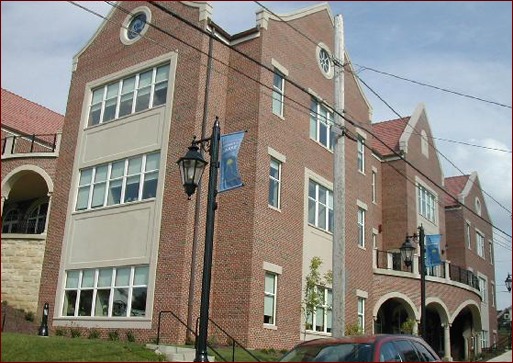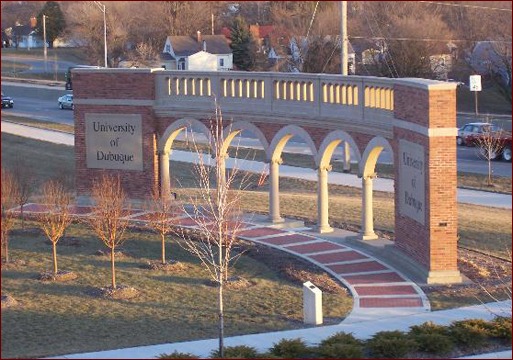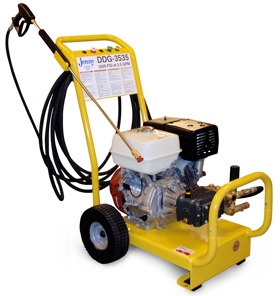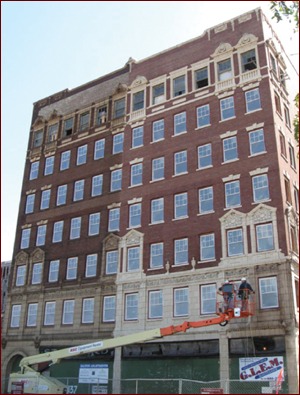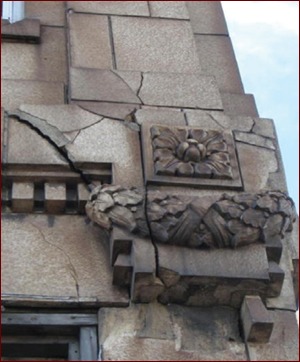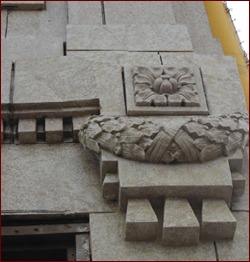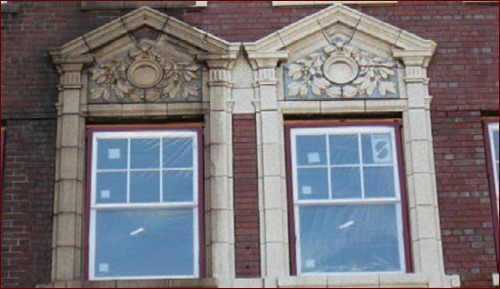Cleaning and Cleaning Equipment
Automation and Control of Your Cleaning Process
Even with 40 years of experience manufacturing masonry cleaning systems, we learn new things from our customers every day. With that in mind, it seemed most valuable to share a few lessons from our customers. The focus is process automation and control. Hopefully, you will find them useful.
Case Study #1 – Productivity of People, Equipment and Materials
Tom Cummer started as a mason in 1985. His company, Cummer Masonry, has grown one of the more successful masonry companies in Iowa, focused on both the commercial and residential markets. “Too many people are trying to make money with the wrong equipment, so they can save up for the right equipment,” Cummer says. He didn’t take this approach, and that was critical to his success.
Cummer applies this approach to all aspects of his business. He thinks about scaffold and the productivity various types will add to his operation. He developed and markets a more efficient mixer. Regarding cleaning, Cummer was trained to clean with a bucket and brush. He knew that if he could do the cleaning portion of the job faster, he could free up masons to lay more wall. He also could free up equipment, scaffolds and man lifts to use them elsewhere, realizing more value from the equipment he had.
To accelerate the cleaning process, Cummer purchased a patented Kem-O-Kleen Masonry Cleaning System long ago. The combination of chemical, chemical activating heat and simultaneous water agitation did the job. He says he has “one guy doing the work of three” with this equipment. Not only did he find he could free up his masons and equipment faster, but also he was able to use chemical more efficiently. With a bucket and brush, a good portion of the chemical had run down the wall and was lost in the dirt. Starting at the top of the wall, being able to precisely control the amount of chemical applied and apply it in the water stream, it flowed down the wall below in an even sheet. As a result, the chemical that was still active, started to evenly work on the wall below and was pretty well used up before it reached the soil. The wall below cleaned even faster, and required far less chemical.
Cummer varies which chemicals he uses to match the material. Regardless of the material and chemical, automating the process has improved his masonry, equipment, and chemical efficiency. And that has improved his business.
Case Study #2 – Hazardous Materials and the Army Corps of Engineers
Michael Almeida learned masonry with Empire Masonry in the Boston area. He liked cleaning and became the in-house masonry cleaner for many years. A few years ago, he started his own cleaning business, and now does work for Empire and a number of the larger, more successful masonry companies in the area. His chemical of choice is Prosoco’s Vana Trol. Something of an innovator, while at Empire, Almeida championed the purchase of a Kem-O-Kleen Masonry Cleaning System. He found that he cleaned far faster and better than ever before, even with the challenges of a densely populated city full of tall buildings to clean.
|
|||
Ft. Devens is a large Army base in a wetlands area, in the towns of Ayer and Shirley in Middlesex County, and the town of Harvard in Worchester County, Mass. As you might imagine, it does not get much tougher than the Army Corps of Engineers when it comes to requirements, unless you also have a bunch of towns and counties in addition. The job was a complex of three, 28-foot tall buildings, containing about 95,000 square feet of masonry. The concern was that the run-off from the cleaning would pose a hazard to the ground. The Corps and city public works officials were pushing for lined trenches to collect all the run-off, transfer the run-off to 55-gallon drums, truck it off-site and treat it. That meant huge costs for capture, transportation and treatment. Rather than proceeding with the off-site treatment solution, the masons requested the opportunity to run tests. By precisely controlling the quantity of Vana Trol applied, the result was a run-off that measured 4.0 ph, which was within the tolerance range for on-site treatment. As a result, the decision was reached to put a small berm of lime around the wash area. Tests of the berm method came back with a ph in the 6.0 to 7.0 range. The expense of the off-site treatment plan was avoided, and the Corps and publics works officials were pleased with the outcome.
Case Study #3 – Consistency
Back in 1977, Tom Buford’s dad was looking at one of the first Kem-O-Kleen machines made. It was being demonstrated at the new Executive Inn construction site.
“I took a look at that machine with all those moving parts and didn’t want any part of it,” says Buford.
But his dad said, “I’ll take it.”
Today, Buford and his wife still operate one of the more successful masonry companies in Kentucky, L. A. Buford Corp. He has bought three Kem-O-Kleens over the years.
Buford drives by a local building that was cleaned with a bucket and brush, by another mason, more than 15 years ago, and says, “They are faded some by now, but you can still see the stripes pretty clearly.”
He has found himself cleaning in the fall, when the weather turned bad. The weather did not permit cleaning until the following spring, and he was able to complete the job with a perfectly consistent look. By controlling the application of chemical, temperature and water pressure precisely, the outcome is consistent. Buford and his brother cleaned a 48,000-square-foot, sandy brick wall, (always a challenge) perfectly consistently, in six hours. Glazed brick, scratch brick, light color, different types of mortar, different times of the year, different types of chemical – it doesn’t matter to Buford. He handles them all perfectly. Consistent process and consistent control of that process give you amazingly consistent results.
Summary
Opportunities exist in the world of masonry cleaning that can contribute significantly to success. Process control and automation give you improved productivity of your people, equipment and chemical. Those savings last long after they have paid for that automation, and your business is better for it. Process control and automation can make your customers confident that you can meet their objectives, whether it is the ph level of run-off or the quality of the finished appearance of the structure. More important, process control and automation give you the capability to deliver that consistency under just about any circumstances.
| Case Study | ||||||||||||||||
| Historic Building Gets Renewed Lease on Life
Roaring ‘20s-era Dalton Apartments in Gary, Ind., has come back from the edge of ruin, thanks to a developer who never lost heart, a thorough interior rehab, and a skilled exterior repair and restoration cleaning. Dalton Apartments actually is two buildings joined by a common wall, the seven-story “Tower” (1928) and the three-story “Modern” (1926). Gary-based developer Harrington Properties planned to revive Dalton Apartments for 1999 occupancy, but those plans came to fruition. Next up, in 2003, Illinois developer Shawn Loyden of Gary Progress Development saw the potential in the building’s downtown location, near a commuter railway station and other public transport, as well as the city’s new baseball stadium. The circumstances “We hung in there,” Loyden says, adding that, in 2010, he was rewarded with some light at the end of the tunnel, as general contractor Sterling Construction Corp. in Mishawaka, Ind., got to work. They tapped Midwest Pressure Washing & Restoration out of Griffith, Ind., a company that also was experienced with historic buildings, to clean the grimy exterior.
The Midwest crew encountered moderate-to-severe carbon staining on the building’s red brick, from 70 to 80 years of exposure to smoke from Gary’s once-prolific steel mills, according to Midwest’s project manager, Tom Skertich. The mortar joints needed to be tuckpointed. The limestone trim crawled with light-to-heavy concentrations of biological growth. Cracks and stains defaced the elegant terra cotta ornamentation, at least where chunks hadn’t fallen away already. Midwest went to work on Dalton Apartments in September. The first task was an overall restoration cleaning. Though the building needed tuckpointing and terra cotta repairs, it had to be cleaned first, so the contaminants wouldn’t interfere with the repairs. At least that was the case on the north, east and west elevations, which only needed limited work. The south elevation was in such dire need that the 100 percent tuckpointing effort had to be the first priority, grimy walls or no grimy walls. Midwest Pressure Washing & Restoration began with the north wall, where a decades-old combination of carbon soiling and biological growth had blackened the masonry more profoundly than any of the other elevations. “From the looks of it, I doubt the north wall ever saw the sun,” says Skertich. The restoration techs wiped the venerable brick free of carbon soiling with Sure Klean Heavy Duty Restoration Cleaner. The product is made specifically to do battle with the accumulated layers of black carbon that often shroud the historic buildings of the urban industrial Midwest and Northeast. Their procedure was simple, says Skertich. Working in 10- X 30-foot drops, the techs soaked down the wall with fresh water. They low-pressure sprayed the wall with Heavy Duty Restoration Cleaner, and gave it a few minutes to de-bond the black mantle. Soft scrubbing with soft-bristle brushes helped hasten the unwelcome coating’s exit, as gentle pressure-washing rinsed it away for capture, treatment and disposal.
The building’s limestone trim, protected by tape and plastic from the cleaner’s acidic components, got washed with the Sure Klean 766 Prewash and Afterwash system, made specifically for cleaning sensitive limestone, marble and travertine. The alkaline 766 Prewash restored the limestone’s pristine appearance. A follow-up cleaning with Sure Klean Limestone Afterwash added a further cleaning effect to the trim, while neutralizing any leftover alkalinity from the Prewash. With the north wall cleaned, the crew began tuckpointing operations on selected areas. They also attacked the dirty east and west elevations. But, since they weren’t as heavily soiled as the north wall, the techs used the milder, though still tough, Sure Klean Restoration Cleaner, using similar procedures as on the north wall. Following the tuckpointing, they removed excess mortar and clarified the mortar joints with Sure Klean 600. The classic, new-construction masonry cleaner also dissolved excess mortar that had been left on the building from a previous tuckpointing attempt in 2008 that hadn’t panned out, Skertich says. They cleaned the old-fashioned way, he says, with buckets and bushes. The cleaned, though still cracked and broken, terra cotta got some attention too, in the form of repairs with Jahn M70 and M90 Restoration Mortars. Midwest wrapped up their work on the building in December as good weather days became ever scarcer. They’d cleaned and repaired three sides but had to wait for Spring to tackle the south elevation. With the first hint of improving weather in March, the technicians were back on the job. The new-construction cleaning crew followed the masons on the south elevation, removing excess mortar, both new and old. The restoration cleaners followed them. In two weeks, they had finished cleaning and repairs. During the course of the project, the Midwest crew had turned back the hands of time on about 90,000 square feet of historic masonry, including roughly 10,000 square feet of tuckpointing and repair. Midwest also treated the development with Sure Klean Weatherseal Siloxane PD (Predilute), a penetrating water repellent. Siloxane PD keeps water from soaking in and creating the very problems Midwest just spent months reversing. Dalton Apartments also got graffiti protection with Sure Klean Weatherseal Blok Guard & Graffiti Control II, a water-based, environmentally responsible anti-graffiti shield. Meanwhile, work continues inside. The finished property will boast 57 newly remodeled apartments and about 7,547 square feet of commercial space and off-street parking. Amenities include wiring for high-speed internet access, energy-efficient windows and doors, community center, exercise center and meeting center. The development, which Loyden says is set for a grand opening in September or sooner, will offer both affordable housing and some market-rate units. With the restoration and rehab, the octogenarian Dalton Apartments have received on new lease on life. How long is that lease good for? “No one ever really knows the answer to that question,” says Skertich. “With proper care and maintenance, I’d say indefinitely.” |

